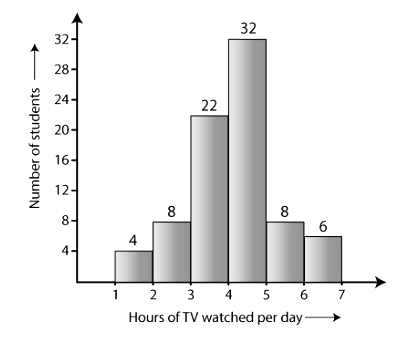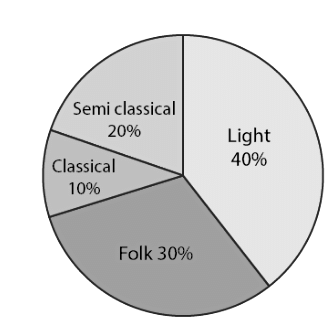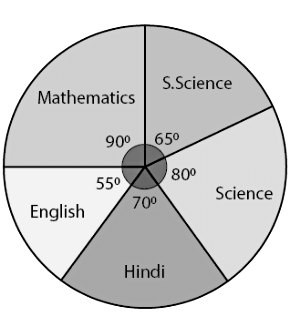Class 8 Maths - Data Handling CBSE Worksheets
| Table of contents |

|
| Frequency Table |

|
| Bar Graphs |

|
| Pie Charts |

|
| Chance and Probability |

|
Frequency Table
Q1: The weekly wages (in Rs.) of 30 workers in a factory are: 830, 835, 890, 810, 835, 836, 869, 845, 898, 890, 820, 860, 832, 833, 855, 845, 804, 808, 812, 840, 885, 835, 835, 836, 878, 840, 868, 890, 806, 840. Using tally marks, make a frequency table for this data.
Bar Graphs
Q1: The number of hours for which students of a particular class watched television during holidays is shown through the given graph. Answer the following:
(i) For how many hours did the maximum number of students watch T.V.?
(ii) How many students watched TV for less than 4 hours?
(iii) How many students spent more than 5 hours watching TV?

Pie Charts
Q1: A survey was made to find the type of music that a certain group of young people liked in a city. The adjoining pie chart shows the findings of this survey. From this pie chart, answer the following:
(i) If 20 people liked classical music, how many young people were surveyed?
(ii) Which type of music is liked by the maximum number of people?
(iii) If a cassette company were to make 1000 CD’s, how many of each type would they make?

Q2: The adjoining pie chart gives the marks scored in an examination by a student in Hindi, English, Mathematics, Social Science and Science. If the total marks obtained by the students were 540, answer the following questions.
(i) In which subject did the student score 105 marks?
(ii) How many more marks were obtained by the student in Mathematics than in Hindi?
(iii) Examine whether the sum of the marks obtained in Social Science and Mathematics is more than that in Science and Hindi.

Q3: The number of students in a hostel, speaking different languages is given below. Display the data in a pie chart.

Chance and Probability
Q1: When a die is thrown, list the outcomes of an event of getting:
(i)
(a) a prime number
(b) not a prime number
(ii)
(a) a number greater than 5
(b) a number not greater than 5.
Q2: Numbers 1 to 10 are written on ten separate slips (one number on one slip), kept in a box and mixed well. One slip is chosen from the box without looking into it. What is the probability of:
(i) getting a number 6?
(ii) getting a number less than 6?
(iii) getting a number greater than 6?
(iv) getting a 1-digit number?
Q3: If you have a spinning wheel with 3 green sectors, 1 blue sector and 1 red sector, what is the probability of getting a green sector? What is the probability of getting a non-blue sector?
You can access the solutions to this worksheet here.
|
79 videos|408 docs|31 tests
|
FAQs on Class 8 Maths - Data Handling CBSE Worksheets
| 1. What is a frequency table and how is it used in data handling? |  |
| 2. How do you create a bar graph from a frequency table? |  |
| 3. What are the advantages of using pie charts in data representation? |  |
| 4. How is chance and probability related to data handling? |  |
| 5. What are some common mistakes to avoid when interpreting bar graphs and pie charts? |  |

|
Explore Courses for Class 8 exam
|

|

















